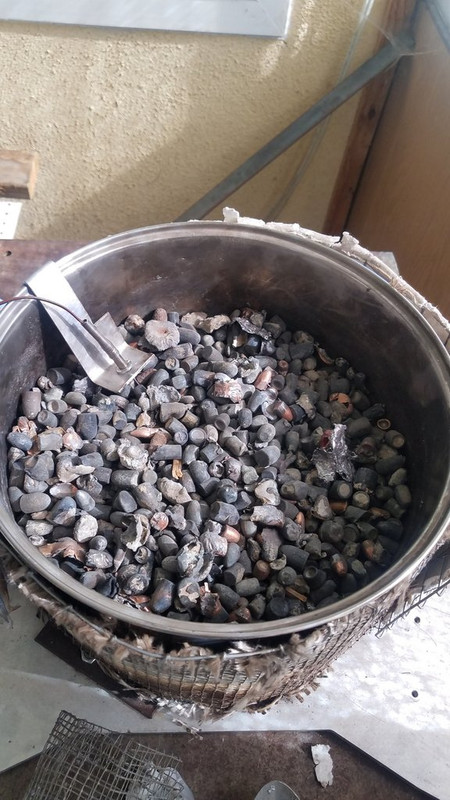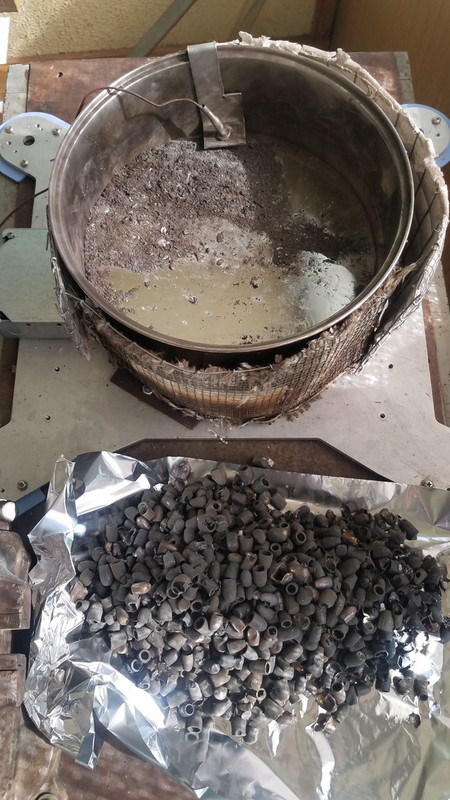Well, the time has come. I've made 100 round batches but its very inefficient when I can shoot those basically in an afternoon. I want to make the leap to a 1000 round batch.
The boolit will be an MP-452-200 hollow point with penta insert. Its a 4 cavity.
My casting experience so far has indicated to me the following challenges (sure to be an incomplete list:
-The sheer amount of boolit casting. I'm going to have to fill, shear sprue, open, shake out, and close that 4 cavity mold 250 times to get 1000. But it will probably be more like 300 times if I include the sure to be failed ones and "heating up" ones. This is not a single day session but I should be able to get it done over a few days. I'm not worried about the overall time as long as I dont WASTE time.
-Keeping the mold clean. After 100 rounds my brass mold has lots of lead specks (not tiny, but not huge) on the mating faces and near the pins. This is not going to make things go smoothly. I need to figure out a way to avoid this happening. I think dipping the mold in the molten lead to get/keep it hot is a major contribute to this. I think I need to move to a hotplate for the mold.
-Lubing the mold cavities..I need to figure out a good way to carbonize/lubricate the cavities to give me as much help as possible dropping boolits. I guess just a sooty flame would work.
-Lubing the mold pins/sprue plate, etc.. I need to make sure I am doing this right, and do it repeatedly as needed during the 1000 mold batch.
-Powder coating or Alox: I need to decide. I have not tried this boolit with ALOX, but I would imagine it would probably work. I think ALOX would actually be easier to do en-masse than powder coating. My PC process is not bad but it just seems ALOX is simpler. Throw a hundred boolits in a bag, squirt in a certain amount of warm alox, massage, drop out on paper overnight (or days) Any opinions on PC vs ALOX for this?
-If powder coating: need a better process for even coating, and preventing defects from boolits touching each other or the baking tray. I do not want to lay 1000 boolits on end for baking.
-LEE load master...need I say more? I think I can roll with the punches with my LEE at this point. I'll have an air-duster on standby and make sure if ANYTHING jams up I am ready to quickly disassemble, blow out, clean out any improper goo/junk, and relube without missing a beat.
-Dies: I am expecting the dies might get a bit overwhelmed with particles. especially the boolit seating die. I'm going to have a quick method to brush it out and clean it every 50 rounds or so. I'm not sure how the sizing and powder through dies will fare. But I will expect some sort of repeated cleaning during 1000 rounds.
-Actual reloading consistency. I'm going to have to come up with a plan for QC to make sure the cartridges that come out all plunk. This is not trivial. I'm not sure how to accomplish this. Out of 50 rounds, I had about 6 that for some reason would not plunk, and repeated runs through the bullet sizer (rotating each time) did not seem to fix it. The seem to have good COAL and so forth. A 12% failure rate is not acceptable for 1000 rounds. So I got to get this down.
Good news:
I have all the components I need! Including 30 lbs of lead for 1000 200gn boolits....
I should be able to convert my PID toaster oven to a mold-preheating oven and/or get a hot plate. Any recommendations?


|
   
   
|


|





 Reply With Quote
Reply With Quote















